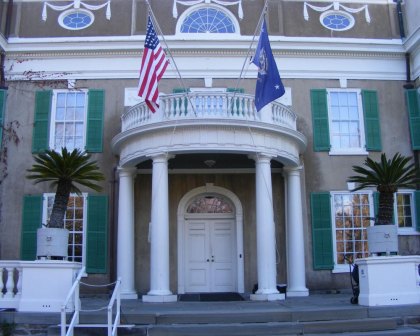FDR's home away from the White House

But Springwood's most famous occupant, Franklin Delano Roosevelt (1882-1945), 32nd president of the United States, is remembered as a champion of the poor and middle-income, as well as the country’s forceful leader during World War II. His presidency stretched from 1933 until his death in 1945. He was the only person to be elected president four times.
The home is nestled in Dutch country -- New York’s Hyde Park. Roosevelt was born there. And he was buried there in a rose garden, alongside his wife, Eleanor, and family dogs. Now part of the National Park Service, Springwood is steeped in the history and ambiance of the time:
- English royals visited in 1939: King George VI was the first reigning monarch to visit the United States. He and his wife, Queen Elizabeth, were entertained first in Washington and then, less formally, at Springwood. Famously, the king and queen were served hotdogs during a picnic. The visit -- June 7-12, 1939 – signaled an era of American-British cooperation important to both nations as war with Germany became inevitable. During the visit King George and Roosevelt spoke of the possibility of war. A typewritten memo of the king’s meeting notes states, “On mentioning the Neutrality Act the president gave us hopes that something could be done to make it less difficult for the USA to help us.” (Read the entire memo on the Roosevelt Presidential Library and Museum website.) Three months later, Sept.1, 1939, the Germans invaded Poland. Two days later, England and France declared war on Germany.
- The boss: We think of Springwood as the president's home, but his mother, Sara Delano Roosevelt (1854-1941), was head of the house until her death. The president knew of his mother's objections to cocktails, so he moved cocktail hour to a cloakroom beneath the stairway, writes Doris Kearns Goodwin in her book No Ordinary Time, (Simon & Schuster; 1994).
- Springwood was originally a farmhouse: The home was renovated in 1915. With the update, it became a "grand stucco and field stone, early-American style mansion," according to the National Park Service. But beyond the design changes, it included space for the Roosevelt's family -- a girl and four boys. A sixth child died as an infant. In 1921, when he was 39 years old, Roosevelt contracted an illness believed to be polio. (Researchers have since questioned that diagnosis.) He was paralyzed as a result. Springwood had a small elevator.
-
Roosevelt’s presidential library was the first. Granted, it isn’t as fancy as the presidential libraries built today, but it started an important trend. Built on the same estate as Springwood, it was the country's first presidential library. Roosevelt wanted the library to preserve his documents and papers. Previously, presidential papers were the “taken from the White House by the president when he left office and were later sold scattered, or kept privately within families,” according to the National Archives website.
-
Roosevelt actually used his library. Indeed, he was also the only president to use his library while in office. He spoke at the dedication ceremony in 1941.
-
In the beginning, the library was controversial: Members of the Senate worried that Roosevelt’s collection “held vital information for their investigations into both Arabian oil deals and WWII contracts,” the library’s website says. Eventually, a Senate committee “was able to examine a majority of the papers, but did not find any relevant information for their investigations."
-
After Roosevelt's death, Springwood was turned over to the park service. The Roosevelt home opened to the public in 1946. Guides make a point of saying that Eleanor Roosevelt greeted guests during the opening. She remained at a modest home nearby called Val-Kill (the word is Dutch and translates roughly as Valley Stream). That home is now the Eleanor Roosevelt National Historic Site.
Related:
Attack inspired "infamy" speech
If you would like to comment, give us a shout, or like us on Facebook and tell us what you think.

